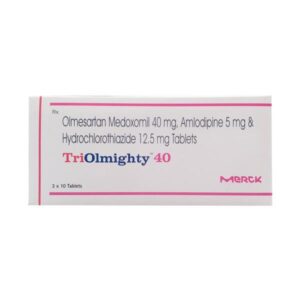AMLODIPINE + OLMESARTAN + HYDROCHOROTHIAZIDE
Amlodipine: Amlodipine is a prescription medication that is primarily used to treat high blood pressure (hypertension) and chest pain (angina). It belongs to a class of drugs called calcium channel blockers.
This medication works by relaxing and widening the blood vessels, allowing blood to flow more easily. It does so by blocking the entry of calcium into the muscle cells of the blood vessels and the heart. By preventing calcium from entering the cells, it reduces the force of contraction of the heart and dilates the blood vessels, thereby lowering blood pressure and improving blood flow to the heart.
The usual starting dose of amlodipine for treating hypertension is 5 mg once daily, which can be increased to a maximum of 10 mg daily if necessary. For angina, the usual dose is 5-10 mg once daily. However, the specific dose may vary depending on individual factors, so it is important to follow the instructions provided by the healthcare provider.
Like any medication, amlodipine may cause side effects. Common side effects include dizziness, headache, flushing, edema (swelling of the ankles or feet), and fatigue. These side effects are usually mild and resolve on their own. However, if they become severe or persist, it is important to notify a healthcare professional.
Rare but serious side effects may occur, such as a rapid or irregular heartbeat, chest pain, severe dizziness, or fainting. If any of these symptoms occur, immediate medical attention should be sought.
Amlodipine may also interact with certain medications, such as other blood pressure medications, certain antibiotics, and grapefruit juice. It is important to inform the healthcare provider about all the medications being taken to avoid potential drug interactions.
Overall, amlodipine is an effective medication for the treatment of hypertension and angina. However, it should only be taken under the guidance of a healthcare provider, who will determine the appropriate dose and monitor for any potential side effects or interactions.
Olmesartan: Olmesartan is a medication that belongs to the class of drugs known as angiotensin II receptor blockers (ARBs). It is primarily used in the treatment of high blood pressure (hypertension) to help lower and control blood pressure levels.
The main mechanism of action of Olmesartan involves blocking the effects of angiotensin II, a hormone that constricts blood vessels and promotes the release of another hormone called aldosterone. By blocking the action of angiotensin II, Olmesartan helps to relax and widen the blood vessels, reducing blood pressure. It also decreases the production and release of aldosterone, which leads to a decrease in fluid retention and further helps in reducing blood pressure.
The typical dose of Olmesartan for most adults with hypertension is 20 mg once daily. However, the prescribed dose may vary depending on the patient’s condition, response to treatment, and any other medications they may be taking.
Common side effects associated with Olmesartan include dizziness, lightheadedness, headache, back pain, cough, diarrhea, and mild stomach pain. These side effects are usually mild and temporary, resolving on their own without any specific treatment. It is advisable to inform a healthcare professional if they persist or worsen.
There have been reports of a rare but serious side effect known as sprue-like enteropathy, which can cause severe, chronic diarrhea with substantial weight loss. Patients experiencing severe prolonged diarrhea should seek medical attention promptly.
As with any medication, it is essential to follow the prescribed dosage and inform a healthcare professional about any existing medical conditions or medications to ensure the safe and effective use of Olmesartan.
Hydrochorothiazide: Hydrochlorothiazide is a medication that is used to treat high blood pressure (hypertension) and fluid retention (edema) in the body. It belongs to a class of drugs known as thiazide diuretics.
The main mechanism of action of hydrochlorothiazide is its diuretic effect. It works by increasing the excretion of sodium and water in the kidneys, which helps to lower blood pressure and reduce fluid accumulation in the body. By increasing urine production, it helps to remove excess fluid from the body, resulting in a decrease in blood volume and ultimately a reduction in blood pressure.
The standard recommended dose of hydrochlorothiazide for hypertension is usually 12.5 to 25 milligrams (mg) taken orally once daily. For edema, the starting dose is usually 25 mg taken orally once daily, which may be adjusted by a healthcare professional based on individual response.
As with any medication, hydrochlorothiazide may cause certain side effects. Some common side effects include dizziness, low blood pressure, electrolyte imbalances (such as low levels of potassium, sodium, and magnesium), increased urination, and muscle cramps. It may also lead to increased blood sugar levels, especially in individuals with diabetes. Less commonly, it can cause skin reactions, gastrointestinal disturbances, and abnormal liver function tests. Additionally, it is important to note that hydrochlorothiazide can interact with other medications, so it is necessary to inform your healthcare provider about all the medications you are taking.
It is essential to follow the prescribed dosage and inform your healthcare provider if you experience any severe or persistent side effects. They can help determine the appropriate course of action, including adjusting the dose or considering alternative medications if necessary.

